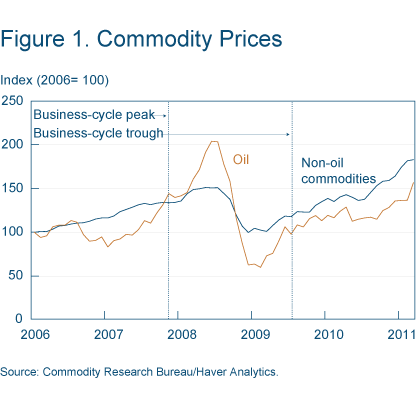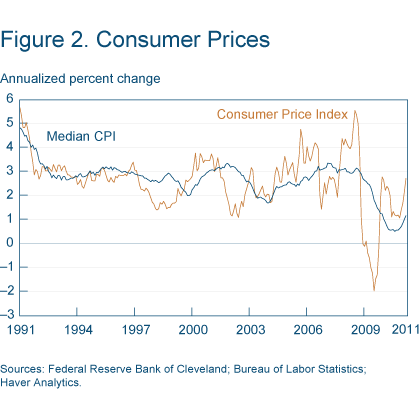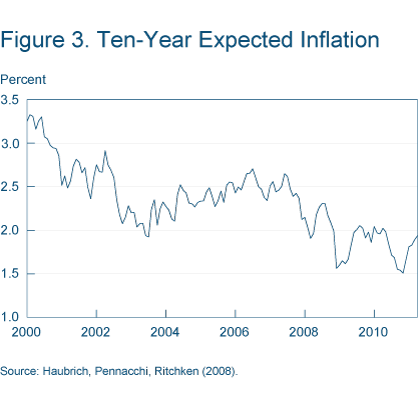- Share
Do Commodity Prices Signal Inflation?
Do the rising commodity prices we have seen in recent years reflect basic supply-and-demand developments in various commodity markets, or are they the first signs of inflation? In practice, it’s not always easy to tell the difference—for the public or policymakers—but fundamentally different they are. Central banks can do nothing about relative commodity-price pressures, since central banks do not produce commodities. Likewise, commodity-price shocks do not impair the ability of central banks to control inflation in principle, but they can greatly complicate the task.
The views authors express in Economic Commentary are theirs and not necessarily those of the Federal Reserve Bank of Cleveland or the Board of Governors of the Federal Reserve System. The series editor is Tasia Hane. This paper and its data are subject to revision; please visit clevelandfed.org for updates.
Commodity prices have been on a sharp upward trajectory since late 2008 (figure 1). Two views of the trend have emerged: One sees these price rises as a reflection of basic supply-and-demand developments in various commodity markets. Those developments are associated with events such as renewed economic growth, some agricultural supply disruptions, and political turmoil in the Middle East. Economists refer to these price increases as relative-price changes. If this view is correct, the price pressures resulting from higher commodity prices—painful as they may be for consumers—will be transitory and will ultimately promote economic efficiency.
Others view commodity prices as the canary in the inflation mine. They contend that commodity prices are surging because central banks, particularly those in the advanced countries, have kept policy too easy for too long. If this view is correct, the recent commodity-price pressures represent the beginning of an inflationary process that will eventually spill into all other prices. These price pressures will persist as long as monetary policy remains excessively easy, and they will prove increasingly difficult to correct the longer monetary policy remains accommodative.
The uncertainty and debate about commodity prices arises because economists often cannot quickly and reliably distinguish underlying inflation trends from relative-price pressures using a standard price measure, like the CPI. To handle this problem, economists construct “core” price indices. The core CPI, for example, excludes food and energy prices because these items are subject to frequent and often substantial relative-price changes. Ideally then, the core CPI provides a glimpse of inflation that is undistorted by relative-price changes.


But relative price shocks can ripple through even the core CPI. Such shocks are not confined to energy and agricultural goods alone, and relative-price changes in one or a few individual markets can affect the production and distribution costs of a wide range of other goods and services. An alternative measure is the Federal Reserve Bank of Cleveland median CPI, which takes the “core” idea to an extreme by subtracting out all CPI components each month except whichever one shows the median price increase for that month (figure 2). Ideally, this abstracts from relative-price pressures altogether and provides a quick, more reliable measure of underlying inflation—“ideally” being the key word here.
This Economic Commentary explains the two views of commodity prices, distinguishing between relative-price pressures and inflation and explaining how commodity-price pressures complicate monetary policy.
Relative-Price Pressures
Consumers—and economists—often cannot easily distinguish between relative-price changes and inflation on a day-to-day, month-to-month, or even on a longer basis. Both sorts of price pressures affect standard price measures similarly, but they differ fundamentally from each other in an economic sense. Relative-price changes arise in modern economies as individual prices adjust to supply-and-demand pressures in their respective markets, and they convey important information about the scarcity of particular goods and services. A rising relative price indicates that demand is outstripping supply, while a falling relative price denotes just the opposite. Turmoil in the Middle East, for example, has disrupted oil supplies and made oil even scarcer, and that has added $14 dollars to a barrel in recent weeks. A rising relative price induces consumers to conserve on the good in question and to look for substitutes. A rising relative price, by increasing profit opportunities, also entices producers to bring more of the good in question to market, if at all possible. In this way, relative-price changes transmit information that is vital for the efficient allocation of resources throughout any market economy. Relative prices make market economies work.
Increases in the prices of commodities—and in the prices of domestic goods made with commodities—have two general impacts on the users of those items. First, they cause consumers and businesses to substitute cheaper alternatives for the higher-priced goods whenever possible. This, so-called substitution effect will likely cause the prices of the alternative goods to rise, too, and while it might possibly also expand the scope of the price increases, the underlying competition tends to limit the size of those increases.
Second, the rise in the prices of commodities and related goods reduces consumers’ and businesses’ purchasing power, much like a tax. When gasoline and food prices rise, consumers have that much less to spend on other things. This, so-called income effect ultimately limits the scope of price increases, unless, of course, income somehow expands along with the price pressures.
For income to grow continuously in the face of higher prices, the Federal Reserve must ease monetary policy. Indeed, the Fed often did so in the 1970s, when the income effect from sharply higher oil prices threatened to lower output and create unemployment. Easing monetary policy in an attempt to minimize output losses can convert a broad-based relative-price hike into inflation with—at best—uncertain, temporary gains to employment and output. Ultimately this monetary accommodation can be self-defeating: The economy still must adjust to elevated commodity prices if commodities remain scarce, and it must confront a higher rate of inflation to boot. By mid-1980, inflation in the United States exceeded 13 percent on a year-over-year basis, and oil remained in short supply.
Inflation—The Other Price Hike
Inflation—one of the most misused words in economics—refers to a decline in consumers’ purchasing power that results when a central bank creates more money than the public desires to hold. It eventually manifests itself as a rise in all prices, as people unload their excess money for goods. If the public’s demand for money grows at 3 percent per year on average, but the central bank expands the money supply by 5 percent per year, all prices and wages will eventually rise by 2 percent per year. The economy experiences a 2 percent rate of inflation. Inflation always results from this monetary mismatch. It has nothing to do with dwindling oil supplies, or excessive wage demands, or out-of-control medical prices. As a monetary phenomenon, inflation is always under the control of a central bank.
That said, the speed with which some amount of excessive money creation (a monetary impulse) filters through to all wages and prices depends on many things. Most importantly, it depends on the state of people’s expectations about inflation and the degree of slack in an economy. In times when the public generally anticipates inflation or when an economy is operating at its full capacity, monetary excesses can quickly translate into higher prices and wages. For that reason, defining inflation as some intermediate-term or long-term path of the CPI is not always helpful.
While inflation will eventually result in a rise in all prices and wages, an inflationary impulse will not affect prices uniformly as it passes through the economy. Contracts and informal business arrangements set many prices—especially wages—for fixed periods of time. Other prices, for example commodity prices, adjust more rapidly—sometimes even in anticipation of monetary policies. In response to a monetary impulse, commodity prices may even overshoot their long-term equilibrium values precisely because the prices of other goods and services are slow to respond. Consequently, economists often look to commodity prices as precursors of general inflation trends.
In contrast to relative-price changes, inflation contains no information about the relative scarcity of particular goods and services. Quite the opposite; the slow, uneven price responses that an inflation impulse causes as it ripples through the economy can send false relative-price signals about the underlying conditions of markets, which cause consumers and businesses to make bad decisions. Because it distorts price signals, inflation creates inefficiencies. This is a key reason, but not the only one, why inflation can prove corrosive to economic growth.
Which Is Which?
At present, the prevailing view sees recent commodity-price trends as reflecting fundamental supply-and-demand developments in specific markets and not as a precursor of future inflation. This relatively benign view derives from the close correspondence between commodity-price movements and real economic growth—that is, commodity-price increases make sense given recent economic events.
Commodity prices rose sharply between 2002 and 2007 prior to the recent worldwide recession (figure 1). During this period, economic growth was strong. The strong growth in emerging and developing economies heightened the typical cyclical pattern in commodity prices. Inflation, however, remained subdued. Oil and non-oil commodity prices then fell sharply during the 2007–2009 recession, as world economic activity crumpled. Commodity prices began rising rapidly again in early 2009 as world economic activity—again led by strong growth among emerging and developing countries—started to recover. Along the way, supply problems among select agricultural goods have added to commodity-price pressures, and over the past couple of months, the conflict in the Middle East has given a further kick to oil prices by disrupting supply and raising uncertainty about future supplies. While overall measures of consumer prices like the CPI have risen sharply in many countries, core price measures have remained subdued. To its advocates, this pattern supports the view that inflation is not busting out.
This prevailing view also sees recent price pressures as transitory; the substitution and income effects will eventually limit their rise, and supply will finally increase in response to higher prices. As proponents of this view often note, commodity-price pressures have had little effect on core-price measures over the past 25 to 30 years—a period during which monetary policy focused on achieving and maintaining price stability.
As noted, the alternative view sees rising commodity prices as a precursor of future inflation. Commodity prices adjust much more rapidly to price pressures, including expected inflation, than other types of consumer-goods prices. Advocates of this view suggest that the recent surge in commodity prices is a response to the unparalleled, near-global easing of monetary policies over the past few years. Liquidity is locked up in banks just waiting to surge out as the recovery matures, and forward-looking commodity markets are merely getting a jump on the anticipated inflation. Although commodity-price shocks may have had little effect on core inflation measures between 1980 and 2000 when monetary policy was well behaved, this is no longer the situation. Some economists suggest that the initial OPEC oil-price hikes in the 1970s were a response to loose U.S. monetary policy and the associated dollar depreciation. The alternative view sees the post-1980 studies as simply not relevant to the current situation.
The Achilles’ heel of the alternative view—the one seeing commodity-price patterns as a signal of future inflation—is that inflation expectations remain subdued in general (figure 3). Still, they have not been stagnant. Inflation expectations have ticked up somewhat in recent months. In addition, the median CPI has also been increasing at a considerable pace recently (figure 1). It has maintained a 2 percent average annual rate—a critical clip for many central banks—over the last three months.

Monetary Policy
Monetary policy can control inflation, but it can do nothing about relative commodity-price pressures, since central banks do not produce commodities. Likewise, commodity-price shocks do not fundamentally impair the ability of central banks to control inflation, but they can greatly complicate the task. They do so in at least three ways.
First, because commodity markets can sometimes signal inflation and because people are not able to quickly distinguish inflation trends from relative-price pressures in the CPI, reading commodity-price patterns can be difficult and can lead to errors.
Second, in an environment of imperfect information, changes in the prices of specific goods—like gasoline and food—can heighten inflation expectations even when inflation is well contained. As the economy moves toward its potential growth path, heightened inflation expectations can raise the output costs of keeping inflation low.
Third, the income effects of commodity-price shocks put downward pressure on real economic growth while putting upward pressure on price indexes. This sometimes makes tightening monetary policy a politically tough choice. In situations like these, central banks need to draw on their reputations for maintaining price stability. If that reservoir is low, a specific inflation target can help.
Recommended Reading
- “On the Origins and Evolution of the Word Inflation,” by Michael F. Bryan. 1997. Federal Reserve Bank of Cleveland, Economic Commentary (October 15).
- “Is It More Expensive, or Does It Just Cost More Money?” by Michael F. Bryan. 2002. Federal Reserve Bank of Cleveland, Economic Commentary (May 15).
- “The Prospects for Inflation Ahead,” by Michael Bordo. 2011. Paper presented at the Shadow Open Market Committee, New York City, March 25. (http://shadowfed.org/archives/)
- “Commodity Prices, Money, and Inflation,” by Frank Browne and David Cronin. 2007. European Central Bank, working paper no. 738 (March).
- “The Effect of Monetary Policy on Real Commodity Prices,” by Jeffrey A. Frankel. 2006. National Bureau of Economic Research, working paper no. 12713.
- “Do Energy-Price Shocks Affect Core-Price Measures?” by Owen Humpage and Eduard Pelz. 2002. Federal Reserve Bank of Cleveland, working paper no. 02-15.
- “Do We Really Know That Oil Caused the Great Stagflation? A Monetarist Alternative,” by Robert Barsky and Lutz Killian. 2002. NBER Macroeconomic Annual 2001, edited by Ben S. Bernanke and Kenneth Rogoff. National Bureau of Economic Research.
- "Estimating Real and Nominal Term Structures Using Treasury Yields, Inflation, Inflation Forecasts, and Inflation Swap Rates,” by Joseph G. Haubrich, George Pennacchi, and Peter Ritchken. 2008. Federal Reserve Bank of Cleveland, working paper no. 08-09 (November).
On the Web
Suggested Citation
Humpage, Owen F. 2011. “Do Commodity Prices Signal Inflation?” Federal Reserve Bank of Cleveland, Economic Commentary 2011-08. https://doi.org/10.26509/frbc-ec-201108
This work by Federal Reserve Bank of Cleveland is licensed under Creative Commons Attribution-NonCommercial 4.0 International





